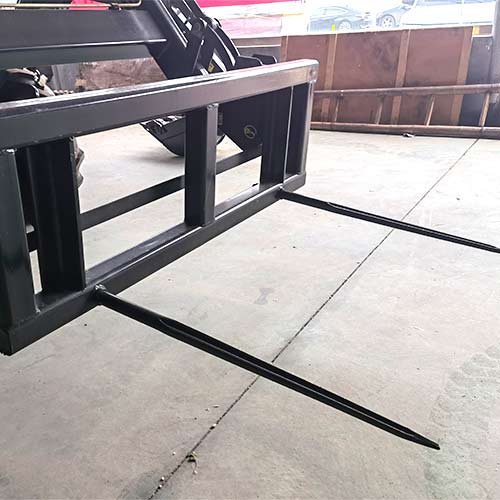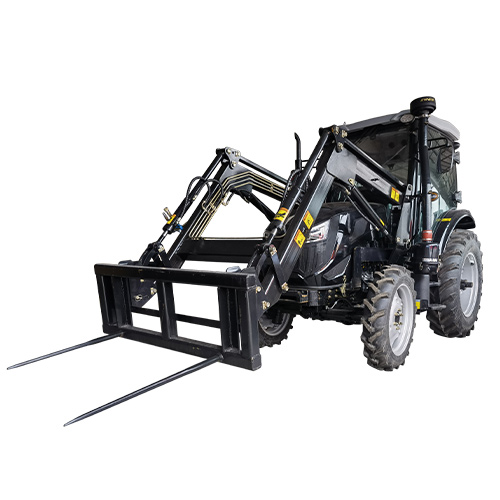Introduction
In the world of agriculture, hay is a vital component for feeding livestock. Moving hay from fields to storage and feeding areas requires efficient and safe transportation methods. Hay fork attachments play a crucial role in this process, transforming tractors and other machinery into versatile hay handling tools.
Types of Hay Fork Attachments

Hay fork attachments come in various designs to suit different hay handling needs. Common types include:
- Round Tine Hay Forks: These forks feature round tines with sharp points that penetrate hay bales effectively. They are ideal for handling large, round bales.
- Square Tine Hay Forks: These forks have square tines with flat edges suitable for handling square hay bales. They provide a secure grip and prevent bales from slipping.
- Grapple Hay Forks: Grapple forks feature two or more hinged arms that close around hay bales, providing a secure and controlled grip. They are particularly useful for handling loose hay or unevenly stacked bales.
- Hydraulic Hay Forks: Hydraulic forks utilize hydraulic cylinders to open and close the tines, allowing for effortless operation from the tractor cab. They are popular for their convenience and efficiency.
Benefits of Using Hay Fork Attachments
Hay fork attachments offer numerous benefits that make them essential tools for hay transportation:
- Increased Efficiency: Hay forks significantly speed up the hay handling process compared to manual methods. They can lift and move multiple bales at once, reducing labor requirements and saving time.
- Reduced Labor Costs: By minimizing manual labor, hay forks lower labor costs and improve overall farm productivity.
- Reduced Hay Loss: Hay forks minimize damage to hay bales during transportation, preventing losses due to tearing or breakage.
- Enhanced Safety: Hay forks eliminate the need for workers to climb onto stacks or reach for bales, reducing the risk of falls and injuries.
Factors to Consider When Choosing a Hay Fork Attachment
When selecting a hay fork attachment, consider the following factors:
- Hay Bale Type: Choose a fork with tines designed for the type of hay bales you handle, whether round, square, or loose hay.
- Lifting Capacity: Ensure the fork’s lifting capacity is adequate for the weight and size of your hay bales.
- Attachment Compatibility: Verify that the fork attachment is compatible with the loader or quick-attach system of your tractor or machinery.
- Hydraulic or Manual Operation: Consider whether hydraulic operation for convenient control or manual operation for simplicity is preferred.
Hay Fork Safety Precautions

When using hay fork attachments, prioritize safety by following these precautions:
- Inspect the Fork Regularly: Check the fork for cracks, worn tines, or loose components before each use.Replace the fork immediately if any issues are found to prevent accidents or injuries during use. It is important to always prioritize safety when handling tools and equipment.
- Proper Bale Placement: Ensure hay bales are securely stacked and positioned correctly on the fork tines.Failure to do so can result in unstable loads, causing potential accidents and injuries. It is important to follow proper stacking procedures to maintain a safe working environment.
- Avoid Overloading: Do not overload the fork beyond its rated lifting capacity.Failure to adhere to this warning may result in damage to the fork, the load being dropped, or serious injury to personnel operating the equipment. Always check the manufacturer’s guidelines for the maximum weight limit before attempting to lift any objects with the fork. It is crucial to prioritize safety and follow all recommended procedures to prevent accidents and ensure the longevity of the equipment.
- Maintain a Safe Distance: Keep bystanders and other equipment away from the working area of the fork.Ensure that only trained and authorized personnel are operating the fork and that all safety precautions are followed at all times. Remember to always inspect the fork for any signs of damage or wear before each use to prevent accidents or injuries.
- Lower Bales Slowly: Lower bales slowly and controlled to prevent tipping or dropping.Make sure to keep a close eye on the stability of the load as you lower it down, adjusting as needed to maintain balance. Remember, safety is always the top priority when handling heavy equipment like bales.
Conclusion
Hay fork attachments are indispensable tools for modern hay handling operations. Their ability to efficiently transport hay, reduce labor costs, minimize hay loss, and enhance safety makes them essential investments for farms and agricultural businesses. By carefully selecting the right hay fork attachment for your specific needs and following safety guidelines, you can optimize hay transportation and ensure the safe and productive handling of your valuable hay crop.
FAQ
Can hay fork attachments be used with different types of hay bales?
Yes, hay fork attachments are designed to handle both square and round hay bales, with various attachment configurations available to accommodate different bale sizes and shapes.
Are hay fork attachments compatible with all types of farm machinery?
Most hay fork attachments are designed to be compatible with a wide range of machinery, including tractors, loaders, skid steers, and telehandlers, but it’s essential to verify compatibility before purchasing or using an attachment.
How do I maintain and care for hay fork attachments?
Regular maintenance, including lubrication of moving parts and inspection for wear or damage, is essential to ensure optimal performance and longevity of hay fork attachments. Follow manufacturer guidelines for maintenance procedures and schedule regular inspections to identify and address any issues promptly.
Can hay fork attachments be used for other materials besides hay?
Yes, while hay fork attachments are specifically designed for handling hay bales, they can also be used for transporting other materials such as straw, feed bags, palletized goods, and agricultural equipment. Just ensure that the attachment’s lifting capacity and configuration are suitable for the material being transported.

